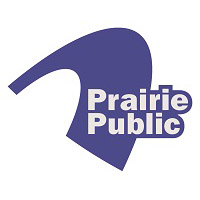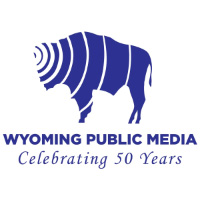This week’s question comes from one of our very own reporters, Leigh Paterson. On a recent trip, she experienced this:
Inside Energy producer Rebecca Jacobson and I visited a coal-fired power plant in eastern Wyoming. We wanted to find out why coal is so reliable and how switching away from it could impact our ability to keep electricity flowing. We started by visiting the plant’s coal stockpile. That part was fairly straightforward: Whenever you need more coal, just scoop up more from your gigantic pile. Then our tour guide took us inside the plant.
The control room at the Laramie River Station is dimly lit with high ceilings, ringed by several grids of computer screens. A guy on the phone was calling an order in for more coal. When we walked in with our camera, workers wearing Carhartts and blue jeans, faces illuminated by the large screens, joked nervously back and forth. As one guy walked me through the plant’s operations, using a touch screen with icons of little boilers and pulverizers, he dropped a lot of new vocabulary, including the concept of inertia. And the more I learned over the course of reporting this story, the more I realized that inertia is a huge factor in grid reliability – not just for coal-fired power plants, but for renewables and the electric grid as a whole.
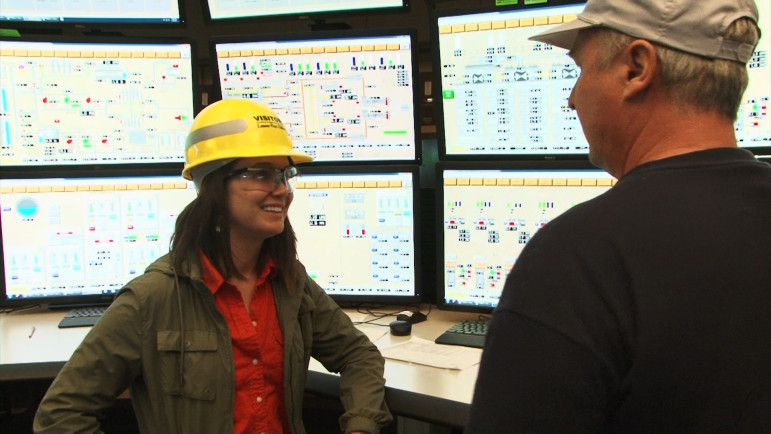
Rebecca Jabobson / Inside Energy
Leigh Paterson in front of the array of screens in the control room at Laramie River Station, a coal-fired power plant in Wyoming.
So, what exactly is inertia? And what role does it play in electricity generation? Question one, we answer today. In an upcoming IE Questions, we’ll tackle why inertia is an essential part of of making sure electricity is there when you need it.
Inertia: A mechanical concept
Inertia is one of the most basic concepts of physics. Essentially, things that are moving will keep moving unless a force – like friction – causes them to stop. And things that are not moving will continue to not move unless a force – like a gust of wind – causes them to move. (Sound familiar? You may have learned about this in high school physics as Newton’s First Law of Motion.)
This concept is simple, but it’s not always easy to see.
Salem State University Assistant Professor of Physics, Anat Burger, (who, full disclosure, also happens to be a good friend of mine) put it this way:
The reason why the concept of inertia was not immediately obvious to everyone before Newton is because our world is filled with sources of friction that act to resist motion. For example, if you give a box a push, it will not continue moving at a constant speed, it will very quickly come to a stop. That is because of the friction acting between the box and the floor. In order to see inertia at work, we need systems that have very low friction, such as in outer space.
Inertia is often best understood through examples, like this one of why a giraffe needs to wear a seat-belt*:
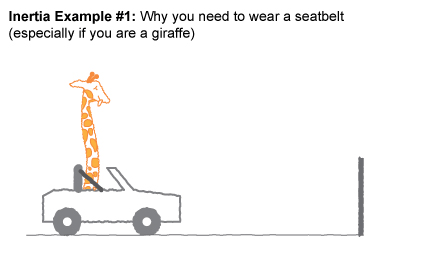
Jordan Wirfs-Brock / Inside Energy
Because of her height, a giraffe still gets a pretty severe case of whiplash, but without a seat-belt her whole body would have been thrown out of the car.
A slightly less intuitive example is what happens when you – or a llama – launches a projectile from a moving vehicle:
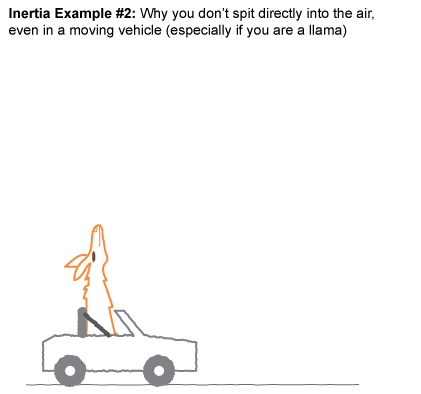
Jordan Wirfs-Brock / Inside Energy
The projectile – er, flying blob of llama saliva – has forward motion when it leaves the car, so it continues moving in that direction and lands right on top of the llama’s head.
Rotating objects also exhibit inertia. Ever wonder what happens if a hamster on a wheel suddenly stops running?
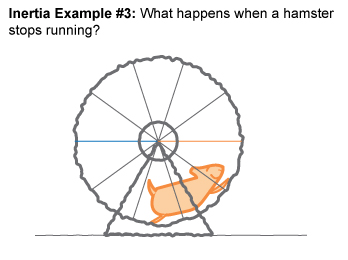
Jordan Wirfs-Brock / Inside Energy
The wheel keeps moving, and the hamster goes right along with it – until friction slows them both down.
So what about power plants? Do they have inertia?
Yes.
Let’s start with a coal-fired power plant: Coal is burned, which produces steam, which spins a turbine, which generates electricity, which is is connected straight to the electric grid. The plant works with the help of a heavy, rotating mass that has inertia. If you suddenly stop burning coal, the turbine will keep spinning – for a while, at least.
In fact, any power plant with moving parts has inertia. Take a hydroelectric power plant or dam: It works the same way as a coal-fired plant, only instead of steam, water turns the turbine. If you magically removed the water and disconnected the turbine from the generator, the turbine would keep spinning until friction stopped it.
To put it another way, if our hamster on a wheel were generating electricity – although you’d need an army of them to power a lightbulb – you could exchange the hamster for a gerbil and it would work the same way. Just like you could exchange coal for natural gas or for water and your power plant would work in much the same way.
Wind farms also have rotational inertia. If the wind turbines are spinning – depending on the size of the turbine, the tips of the blades can move at speeds of 180 miles per hour – and the wind suddenly stops, the turbines will keep moving until friction, and the conversion of rotational energy to electricity, slows them down.
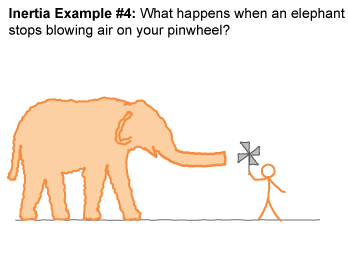
Jordan Wirfs-Brock / Inside Energy
The pinwheel keeps moving, even after the elephant stops blowing.
What about solar power? This is the key issue with inertia and renewable: Solar panels, or photovoltaic cells, don’t have any moving parts, so they don’t have any mechanical inertia. When the sun stops shining, because clouds roll in or there’s an eclipse, the solar panels stop generating electricity immediately.
But the reverse is also true: When the clouds roll away, solar panels immediately start generating electricity at full capacity. Not so for those power plants with big, heavy, spinning parts: It takes some time for the turbines in a coal-fired power plant to get back up to full speed.
When we hook individual power sources – nuclear plants, wind farms, solar gardens, natural gas plants – up to the electric grid, the reliability of the entire system depends on the concept of inertia. To understand why, we’ll need to go beyond spinning hamsters and frustrated llamas and dive into something called “frequency response,” and even revisit the historic AC/DC battle. For that, check out part two of our investigation into inertia and the electric grid.
*Note: The animated gifs were not made using a physics simulator. Their motion represents a rough approximation of Newtonian physics.
Have an idea for an energy topic that could be fun in the classroom? Submit it below.





